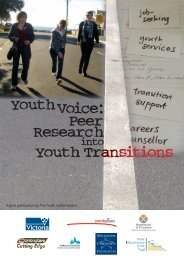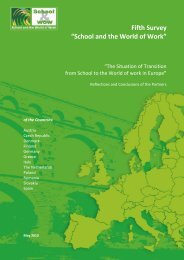Second Survey School and WOW.pdf
Second Survey School and WOW.pdf
Second Survey School and WOW.pdf
Create successful ePaper yourself
Turn your PDF publications into a flip-book with our unique Google optimized e-Paper software.
WORKING GROUP: PRINCIPLES AND CRITERIA<br />
The quantitative aspects lead to questions like the duration of the programs <strong>and</strong> the risk of<br />
long term unemployment, the school type or region aspects <strong>and</strong> the number of school leavers<br />
as well as the outcome of specific guidance measures <strong>and</strong> the reduction of the numbers<br />
described. From our theoretical view, the individual aspects (like orientation, reflexivity) <strong>and</strong><br />
the structural aspects (local labour marked) are linked very close 28 <strong>and</strong> can be integrated in a<br />
systemic manner.<br />
Some of the other qualitative <strong>and</strong> quantitative benchmarks that are also relevant for the<br />
evaluation of guidance instruments are described in sector 2.1.1, 2.2.1. <strong>and</strong> 2.2.2. The most<br />
crucial point in our view is the quality of the data the evaluation is creating. For example, if we<br />
want to identify the outcome of an project in the metropol region “Rhein Neckar”, based on<br />
more than 20 schools, it is not enough to make a follow up to count the drop outs afterwards,<br />
to measure the duration of job search or to measure the number of break offs in vocational<br />
education, we need also a comparable data base. The first method we can choose is to<br />
evaluate a test group, the other one is to develop a general regional data base on all this<br />
issues. Of course such an data base is not only interesting for the measurement of<br />
effectiveness of guidance activities but also on all other activities in respect to education,<br />
regional labour marked <strong>and</strong> so one.<br />
The Netherl<strong>and</strong>s<br />
See II.2.2.1 <strong>and</strong> II.2.2.2<br />
Pol<strong>and</strong><br />
Most scenarios of direct work with youth concern with developing various skills like:<br />
<br />
<br />
<br />
<br />
<br />
<br />
<br />
Self recognition<br />
Assessment of own potential<br />
Getting a proper vocational information<br />
Decision taking<br />
Methods for self presentation (in various situations)<br />
Active job seeking<br />
Etc.<br />
About 20% of gymnasium graduates choose vocational schools <strong>and</strong> the rest choose lyceums or<br />
technical high schools. Almost all need counsellor’s help. However the benchmarks are very<br />
poor: there is about 20 000 gymnasiums <strong>and</strong> secondary schools <strong>and</strong> about 1500 vocational<br />
counsellors providing service outside <strong>and</strong> within schools, only.<br />
28 B<strong>and</strong>ura 2005; Schiersmann 2008<br />
‐ 44 ‐




